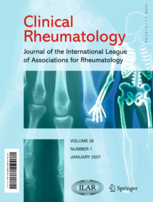
Clinical, but no ultrasonographic, improvement of lateral epicondylitis with 3 treatments

Clinical, but no ultrasonographic, improvement of lateral epicondylitis with 3 treatments
Physical therapy, corticosteroid injection, and extracorporeal shock wave treatment in lateral epicondylitis. Clinical and ultrasonographical comparison
Clin Rheumatol. 2012 May;31(5):807-12. doi: 10.1007/s10067-012-1939-y. Epub 2012 Jan 27Synopsis
59 patients diagnosed with the condition lateral epicondylitis (LE), were randomised into three groups to undergo either physical therapy, a single corticosteroid injection, or extracorporeal shock wave treatment (ESWT), to determine which technique was the most effective in treating LE. Following assessments measured over 6 months, results displayed that all three methods used for LE treatment had positive outcomes regarding reduction in pain and an increase in grip strength in early stages. However, there were no differences in thickness and cortical abnormalities of the common extensor tendon and bony cortex of the lateral epicondyle, measured using the ultrasonography, prior to and 6 months after treatment.
Was the allocation sequence adequately generated?
Was allocation adequately concealed?
Blinding Treatment Providers: Was knowledge of the allocated interventions adequately prevented?
Blinding Outcome Assessors: Was knowledge of the allocated interventions adequately prevented?
Blinding Patients: Was knowledge of the allocated interventions adequately prevented?
Was loss to follow-up (missing outcome data) infrequent?
Are reports of the study free of suggestion of selective outcome reporting?
Were outcomes objective, patient-important and assessed in a manner to limit bias (ie. duplicate assessors, Independent assessors)?
Was the sample size sufficiently large to assure a balance of prognosis and sufficiently large number of outcome events?
Was investigator expertise/experience with both treatment and control techniques likely the same (ie.were criteria for surgeon participation/expertise provided)?
Yes = 1
Uncertain = 0.5
Not Relevant = 0
No = 0
The Reporting Criteria Assessment evaluates the transparency with which authors report the methodological and trial characteristics of the trial within the publication. The assessment is divided into five categories which are presented below.
2/4
Randomization
3/4
Outcome Measurements
4/4
Inclusion / Exclusion
4/4
Therapy Description
3/4
Statistics
Detsky AS, Naylor CD, O'Rourke K, McGeer AJ, L'Abbé KA. J Clin Epidemiol. 1992;45:255-65
The Fragility Index is a tool that aids in the interpretation of significant findings, providing a measure of strength for a result. The Fragility Index represents the number of consecutive events that need to be added to a dichotomous outcome to make the finding no longer significant. A small number represents a weaker finding and a large number represents a stronger finding.
Why was this study needed now?
The most common condition associated with elbow pain is lateral epicondylitis (LE). LE results from the overuse of an injured extensor tendon of the dominant upper extremity. The condition is commonly treated through deep tendon friction massage, mobilization, physiotherapy exercises, stretching and strengthening exercises, splints, and local corticosteroid injections. Recently, shockwave therapy and Cyriax therapy have also been suggested to alleviate pain caused by LE. However, in the few comparisons that have been made between treatment types, the results have been conflicting. Hence, this study aimed to determine which of the treatment methods is more efficient in treating LE, through the clinical and ultrasonographic comparison of therapeutic effects.
What was the principal research question?
Were there any significant differences in outcomes between physical therapy, corticosteroid injection, and ESWT in patients with LE when compared clinically versus ultrasonographically, when measured over a 6 month period?
What were the important findings?
- Clinical findings indicated that there was a significant decrease in VAS scores for all three groups at months 1, 3, and 6 following treatment (p<0.001). VAS scores were similar for all three groups.
- Clinical results showed there was a significant increase in grip strength values on months 1 and 3 of treatment for Group I (Physiotherapy Group), month 1 for Group II (Injection Group), and months 1, 3, and 6 for Group III (ESWT Group) (Month 1, p<0.003; Months 3 and 6, p<0.001).
- However, ultrasonographic findings did not correlate with the results regarding improvement in pain scores and grip strength.
- There was no significant difference in pinch strength values between the three groups (p>0.05).
- There was no significant difference in the cortical irregularities of the extensor tendon prior to treatment and at 6 months of treatment for all three groups (p>0.05).
What should I remember most?
The clinical findings demonstrated similar reductions in pain, increases in grip strength and finger pinch strength in early stages of LE treatment with physical therapy, corticosteroid injection, and ESWT. However, these changes observed clinically were not supported ultrasonographically. Rather, no differences in thickness and cortical abnormalities of the common extensor tendon and bony cortex of the lateral epicondyle were seen when measured prior and 6 months after treatment.
How will this affect the care of my patients?
Since clinical effects of the LE treatment were not supported ultrasonographically, confusion remains in what the long term effects of physical therapy, corticosteroid injection, and ESWT are. In future studies patients should be blinded in order to lower the potential risk of bias, the population size should be increased, and longer follow-up periods should be used.
Learn about our AI Driven
High Impact Search Feature
Our AI driven High Impact metric calculates the impact an article will have by considering both the publishing journal and the content of the article itself. Built using the latest advances in natural language processing, OE High Impact predicts an article’s future number of citations better than impact factor alone.
Continue



 LOGIN
LOGIN

Join the Conversation
Please Login or Join to leave comments.